When I got a little bored with Chinatown for my lunch, I ventured into Tiong Bahru; and it was then that I began to have a good look at the pre-war section of the estate. It was disconcerting at first, for at what is possibly Singapore's first UNESCO World Heritage Site (see the dream), streets run parallel and at right angles, and every corner of those art-deco buildings looks identical. I panicked when surrounded by these unfamiliar buildings in white: how was I to get back to Si Pai Por? Eventually I managed to find my way around the estate, thanks to the frequent makan session and little exploratory walk before heading back to work. There are so many things in this pre-war estate that we can talk about, other than "bird corner", "art-deco", "delicious food", "bomb shelter" and what have you. Where shall I start then?
It was only after I was lost for the first few visits, having made no heads or tails of an estate where every corner looks the same to me, that I decided to read up and chanced upon a photo of SIT flats taken before the war. This is one stunning historical photo showing the very first block of SIT flats in Tiong Bahru district when it was completed in late 1936. Suddenly history came alive and no longer was I looking at food or identical art-deco corners, instead I was witnessing the genesis of the estate, the first one to be developed from scratch by SIT, and its first block, this would have been the first SIT flats in Singapore!
1936 photo of the first Tiong Bahru flats (source: ST). I could not recognize this block at first as all corners in the estate "look the same". The first block was erected at one corner of the estate which I later learnt to be the junction of Tiong Bahru and Tiong Poh roads. It was built to impress, as one drove into Tiong Bahru from Outram Road, he would be greeted by this sweeping view of the block.
It is a different story today on the same approach to Tiong Bahru. Trees, an ugly link bridge and even renovations on the block - fitting of air-con units, enclosing of balconies with windows - mean the grand sweeping view of the historical block is anything but history.
It was here that I learnt not all three storey blocks have "identical corners". This one looks different, due to a longer diagonal at the corner where the prata restaurant is today. From the photo, it would seem Tiong Bahru Road was originally three-lane and land on the right was acquired for a fourth.
From the ST report, I now have a better idea of its history; in other words the block as when it was first designed and not the "history" erased or created by modern-day occupants.
"In all there are 28 flats and four shops, above which are 14 rooms. The ground floor is taken up by eight flats and two shops at each end. The first and second floors have ten flats each. Flats on the ground floor have two rooms and a dining hall, on the upper floors three rooms and a dining hall ... All the flats are equipped with a basin and draining board, a kitchen, neat and strong, and a larder with three lockers. The bathroom and water closet are well ventilated, and the flush system is used. For ground floor flats $20 per month is charged. Upper floors let for $22 per month."
Considering most of the working class drew a salary from $12 to $20 a month, the rent would have been exorbitant! This was the greatest irony of these SIT flats: they did not solve the problem they were meant to tackle, which was to alleviate overcrowding conditions in the town area. These flats were simply quite unaffordable for the folks in overcrowded districts. Furthermore the price point didn't feel quite right, why would a two-rooms cost $20 to rent and a three-rooms only 10% more?
When PAP formed the government in 1959 and the HDB established in 1960 to tackle the same problem, they were much smarter. Before the home ownership scheme in 1964, the one-room "Emergency Type" flats were rented out at $20, two-room at $40 and three-room at $60. Adjusting for inflation, the $20 in 1936 would have been worth much more in the 60s. I note that the currency used in 1936 - the Straits dollars - was replaced at par by the Malayan dollar in 1939.
I checked out the ground floor of Blk 55 to ascertain the facts in the report. Indeed, there were eight staircases with three letterboxes. I found other staircases with only two letterboxes or none. The extra letterbox belongs to the unit on the ground floor. Thus, my observation agrees with what was written in the report - "the ground floor is taken up by eight flats ... the first and second floors have ten flats each".
The eight staircases with three letterboxes corresponding to the eight flats on the ground floor. I was told by Peter the original address did not include the block number we see today. In other words they use the shophouse-type address convention, i.e. A for first floor, B for second floor, no letter denotes ground floor. For Blk 55, the original addresses could have been #37, #39, #41, #43, #45, #47, #49, #51, #53, #55, #57, #59 with the four shops taking the first and last two addresses.
Confusing? Here are the inconsistencies from my observation. There should be two shops at each end according to the report, but there are five shops today. So which is the odd one out? I'm not sure also what the report meant by 14 rooms above the four shops; I counted the windows above the shops but could not arrive at this "magic figure". After checking Google street view, I realized one or two staircases are also unaccounted for in my photos.
Guan Hin at #01-57. Possibly the oldest provision shop in Tiong Bahru which opened in 1955. The shop was documented in NHB travelling exhibition on provision shops (here). Sadly I read that it has closed down?! The 'kar tor' scissors gate was closed when I visited, the interior was in darkness but I could still make out some furniture inside. I also read a bakery or confectionery is taking over the space though there is already one at #01-39.
Hup Seng at #01-02, provision shop at the other end of the block from Guan Hin. Won't the two old provision shops be in competition then? From the odd-address, I suspect this and the Indian Restaurant next door (#01-37) were one shop originally but separated. What do you think?
Can we verify ground floor units have two rooms (instead of three) and a dining hall? I found out there is a french bookshop at one of the ground units that I'm quite sure was a flat previously. This is a perfect opportunity to check out the interior of the first SIT flats in Tiong Bahru though the interior may have been reworked. Regrettably I did not enter the bookshop as I had to head back to work!





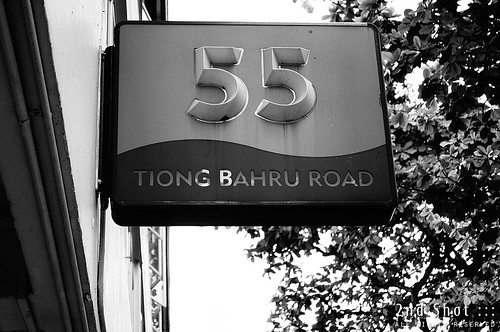
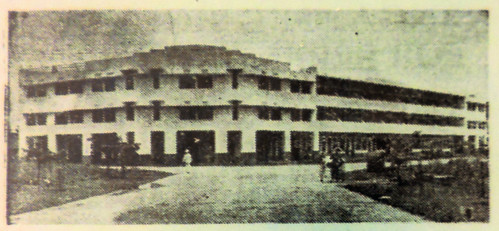
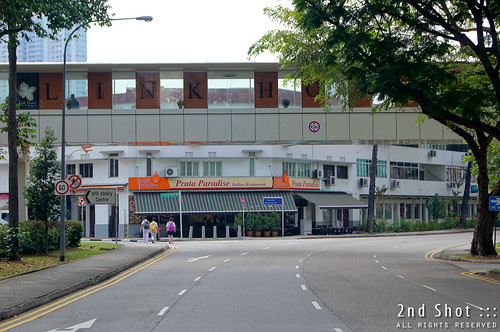

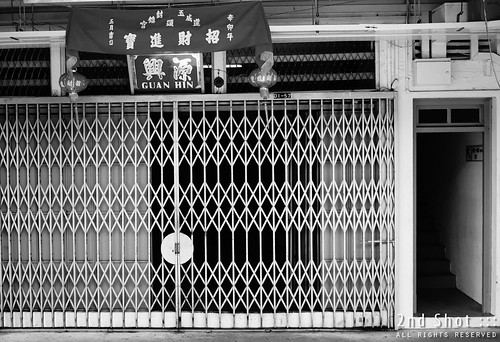
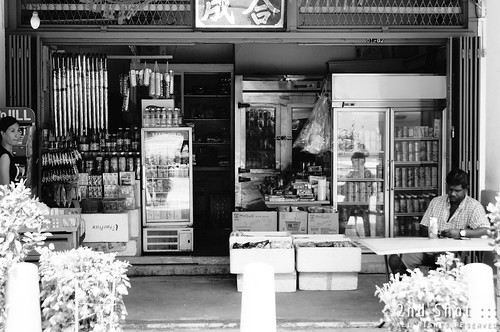
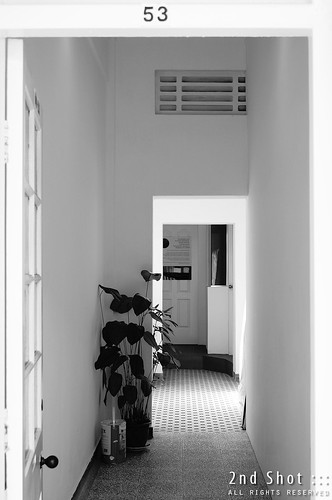










9 comments:
Prata Store was a unit by itself. It was a "kopi char poh" with an unsual sight - it had a juke box spinning records.
There were a wanton mee stall, a chay kway teow stall, a ngoh hiang stall and the coffee/tea/soft drinks stall. The drinks stall had a big refrigerator - 2 door - which stored the soft drinks. Below the fridge was the freezer where other stall owners would store their perishables like veggies and meat.
No non-Chinese stalls were at this kopi tiam.
This corner coffee shop popular with doctors and nurses from Outram GH or SGH now.
All ground floor residential units have 2 bedrooms/1 living room/1 air well/1 backyard/1 kitchen cum dining room/1 WC/1 shower/1 store room.
Second/Third Floor has 3 bedrooms (2 sharing a balcony)/1 kitchen cum dining room/1living Room/1 WC/1 shower/1 store room.
Ground floor shops have 1 bedroom/1backyard/1 WC/1 shower/1 store room/1 kitchen cum dining room.
All original ground floor residential units have main entrance accessible from common staircase.
I forgot the yong tau foo stall at that "kopi char poh". There was a long u-shaped bar table owned by the cofee stall owner facing Tiong Bahru Road (cashier operated from this table). On that table were glass jars selling biscuits. Cofee/tea were prepared at a table next to the fridge which was parked in front of the kitchen.
Hello. I came across your blog while doing researches for Tiong Bahru. Actually right now, I'm working on my final year project in LASALLE and it's about appreciating existing heritage (because we often take things for granted and with modernisation, our environment changes very fast). Therefore, it's interesting to see your write-up, about discovering more about the detail structure of the building and not just by the exterior art-deco design. It's something that I have never thought of.
This article kinds of inspires me to look at the structures from another perspective. And also, I will be collecting interesting stories from residents in Tiong Bahru, because other than architecture, the people are also the ones that make Tiong Bahru a unique heritage. Their lifestyle, the happenings in Tiong Bahru. Something that only residents will probably know or often see, and not visitors like us.
Hello. I came across your blog while doing researches for Tiong Bahru. Actually right now, I'm working on my final year project in LASALLE and it's about appreciating existing heritage (because we often take things for granted and with modernisation, our environment changes very fast). Therefore, it's interesting to see your write-up, about discovering more about the detail structure of the building and not just by the exterior art-deco design. It's something that I have never thought of.
This article kinds of inspires me to look at the structures from another perspective. And also, I will be collecting interesting stories from residents in Tiong Bahru, because other than architecture, the people are also the ones that make Tiong Bahru a unique heritage. Their lifestyle, the happenings in Tiong Bahru. Something that only residents will probably know or often see, and not visitors like us.
I'm sorry about the repeated posts. Something went wrong and the next moment I realised two identical posts were posted.
Hi Shanlyn, thanks for your comments. Hope you uncover more tidbits from the residents for your final year project. Like you, I'm also part of the younger generation amazed by the little things hidden in landmarks around us we otherwise take for granted. Hope you like my second shot perspective of heritage and investigative writeup.
Hi! I am a student working on a project regarding Tiong Bahru and the recents cafes and restaurants that have appeared in the area. I noticed that you have reviewed some of them and also have thoughts about the estate in your blog.
Would you be so kind as to help me fill up this survey regarding the Tiong Bahru estate? It will take less than 10 mins at most, thank you for your time!
I can be contacted at vongxy_91@hotmail.com if needed.
Link : https://docs.google.com/forms/d/128jBWQvfCb0gLEqJdvfQpfyn6000PHwqdV4losiEzuI/viewform
Hi! I recently came across your old blog post...really interesting post on the block 55 tiong bahru SIT flats. I grew up in one of the ground floor flats in that very block, and can confirm that the layout contains 2 bedrooms. When you enter, it is a squarish living room where the main door opens from. There is a longish alleyway connecting the living room to the dining hall/ bathrooms/ kitchen area (the alleyway is also where the 2 bedrooms are located). I'm not sure if you can visualise it based on my description but suffice to say the flats are laid out in a most unique way that is practically unseen in today's HDB flats.
At the corner of block 55 (next to the popular Glacier bakery), there used to be the most amazing coffeeshop. The wanton mee stall there (by an elderly couple), remains the best wanton mee I have eaten ever in my life and nothing quite comes close. Elderly uncle used to do the cooking while the wife served the noodles to customers. He would throw in random chicken parts into your noodles which he used to boil the flavorsome soup with. Sadly, they stopped selling when the wife (I think) was in poor health. A pity - they were true hawker legends. Next to the wanton mee stall was the famous Tiong Bahru ngoh hiang - always a long queue esp at lunchtime. It was manned by a husband and wife team too, but they were always squabbling while cooking, which was mildly entertaining to say the least. Heard this stall is now is Tj Pagar complex and still draws queues. The rest of the stalls included a prawn noodle stall and a dim sum stall I used to eat at as a kid.
Block 55 tiong bahru has some pretty precious memories for me. Although my extended family still lives in the flat there and I visit once in awhile, the area is really no longer the same. Personally, I dislike the new Tiong Bahru of today with all its hipster cafes pushing out the very shops and stalls which were there since day 1, and that made Tiong Bahru so unique. Sometimes I doubt these foreigners and hipsters even know the real, old Tiong Bahru of yore when they walk around with their DSLR cameras and phones snapping away or Instagramming. Thanks for writing this post. I definitely walked down memory lane tonight.
Post a Comment